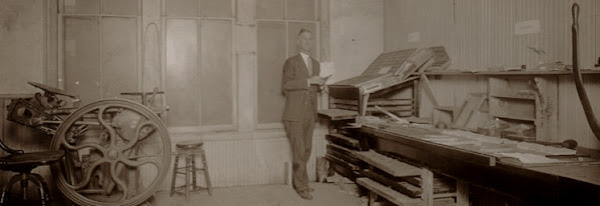The time in this case is somewhere in the latter half of the 19th century. I found a little time capsule in the Kelton copper plate press today. But let me lay some groundwork.
Presses of this type, especially older ones, needed the lower roller adjusted to come into contact with the underside of the press bed. This was done quite simply using shims under the bronze bearing blocks. Any hard, stable material will do, thick and thin pieces being used as required. Wood and paper were sometimes used but these materials are dynamic, expanding or contracting with changes in the humidity, and therefore not the best. A possible exception would be oiled paper such as tympan that is both hard and stable. Steel, iron, copper, and brass were all more appropriate choices.
I had disassembled the Kelton as much as possible with the exception of the lower roller. I was able to remove the bearing blocks and shims but removing the roller itself would require taking the main frame completely apart. This wasn’t necessary as I could clean everything with the roller in place and supported by two pipes. I cleaned the bearing blocks today and the shims and it was here that I made my discovery.
The press has been moved at least four times in its life including from the factory to its first owner. Adjustment of the roller would have taken place after that first move and I think I know enough about the subsequent life of the press to state that no one has likely changed this initial adjustment. The roller is very heavy and holds the shims in place quite securely. By the time I got it the shims were pretty much glued in place as well with the gunk of the ages and the paint one of the previous owners had sloped on to make it shiny looking. Further examination bore out that they were certainly very old.
On both sides they consist of small steel plates, a few brass pieces of two different thicknesses, and on one side two pieces of oiled paper, possibly tympan. While the steel plates were for the most part unremarkable, one of them contained some evidence of the craft for which the press was intended. An example of this craft in action can be seen in the circa 1860 illustration below of the press room of the American Bank Note Company in New York City.
Presses of this type, especially older ones, needed the lower roller adjusted to come into contact with the underside of the press bed. This was done quite simply using shims under the bronze bearing blocks. Any hard, stable material will do, thick and thin pieces being used as required. Wood and paper were sometimes used but these materials are dynamic, expanding or contracting with changes in the humidity, and therefore not the best. A possible exception would be oiled paper such as tympan that is both hard and stable. Steel, iron, copper, and brass were all more appropriate choices.
I had disassembled the Kelton as much as possible with the exception of the lower roller. I was able to remove the bearing blocks and shims but removing the roller itself would require taking the main frame completely apart. This wasn’t necessary as I could clean everything with the roller in place and supported by two pipes. I cleaned the bearing blocks today and the shims and it was here that I made my discovery.
The press has been moved at least four times in its life including from the factory to its first owner. Adjustment of the roller would have taken place after that first move and I think I know enough about the subsequent life of the press to state that no one has likely changed this initial adjustment. The roller is very heavy and holds the shims in place quite securely. By the time I got it the shims were pretty much glued in place as well with the gunk of the ages and the paint one of the previous owners had sloped on to make it shiny looking. Further examination bore out that they were certainly very old.
On both sides they consist of small steel plates, a few brass pieces of two different thicknesses, and on one side two pieces of oiled paper, possibly tympan. While the steel plates were for the most part unremarkable, one of them contained some evidence of the craft for which the press was intended. An example of this craft in action can be seen in the circa 1860 illustration below of the press room of the American Bank Note Company in New York City.

Copper and other plates used for intaglio printing have a bevel filed at the outer top edges, sometimes at a 45-degree angle but more often one less steep. The purpose of the bevel is to keep the otherwise sharp right angle of the edge from cutting into the paper under the great pressure exerted during printing. Anyone who has seen an intaglio print will likely remember that the edge of the plate is visible at the outside of the image. Even today plates do not come this way from the factory but the printer files the bevel himself. What I found on one of the steel shims was this hand-filed bevel.
The plate is 1/8” thick, a standard gauge for printing, and approximately 1 ¾” by 2” though not a perfect rectangle but a rather accurate parallelogram. As you can see from the photo, there are two holes drilled into it and it has numerous scratches in it. On one side the bevel is a fairly consistent 1/16” wide while on the reverse the edge has only been filed slightly, a distinct bevel but just enough to remove the sharp edge.
The plate is 1/8” thick, a standard gauge for printing, and approximately 1 ¾” by 2” though not a perfect rectangle but a rather accurate parallelogram. As you can see from the photo, there are two holes drilled into it and it has numerous scratches in it. On one side the bevel is a fairly consistent 1/16” wide while on the reverse the edge has only been filed slightly, a distinct bevel but just enough to remove the sharp edge.

I can’t explain the reason why this small plate was prepared as if it was to be used for engraving or etching a print on it. Perhaps it was done for practice. Or perhaps when making a shim for the press the force of habit took over when removing the sharp burr at the edges. I do plan on reusing the original shims now that I’ve cleaned them and if further adjustments are needed simply adding to those. But I’m tempted to replace this one with a new piece of steel.
The stories this press could tell and in some ways is telling, eh?
The stories this press could tell and in some ways is telling, eh?



No comments:
Post a Comment